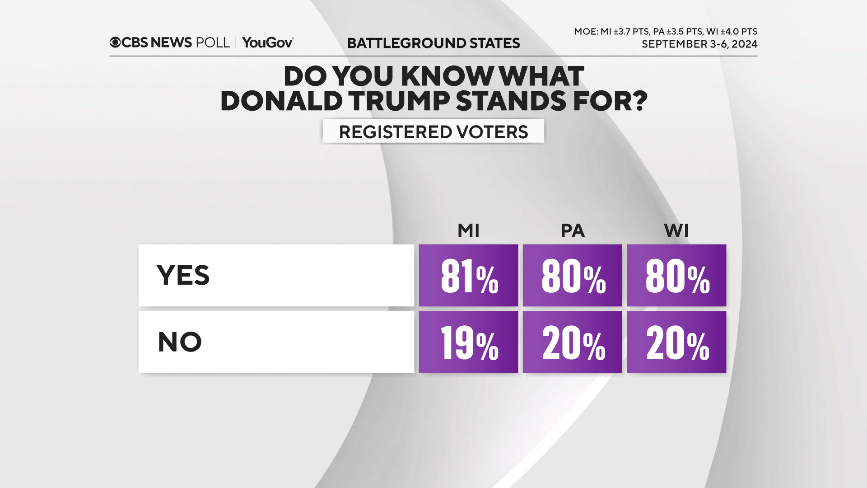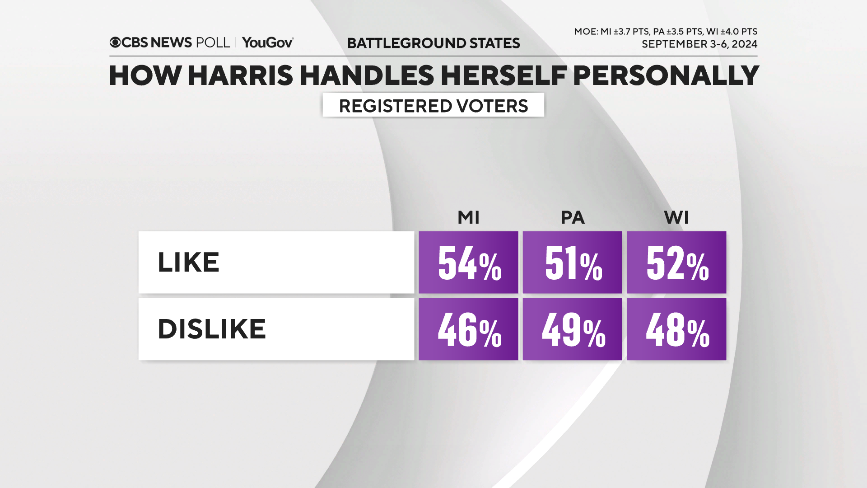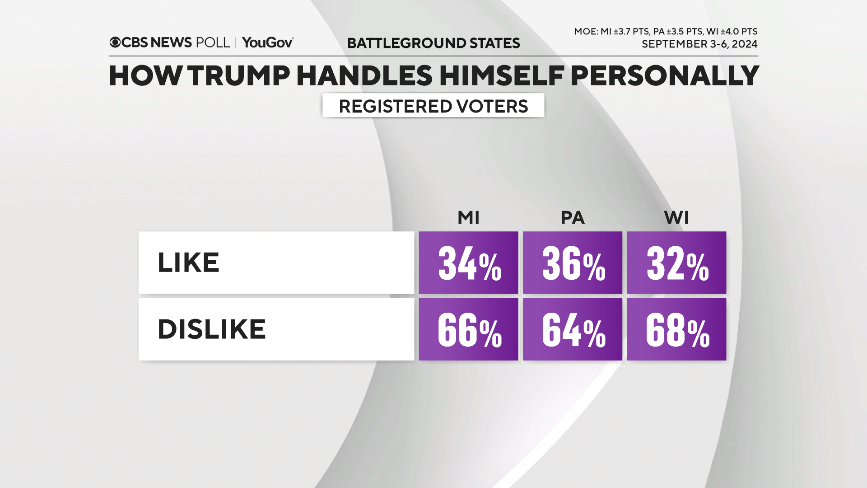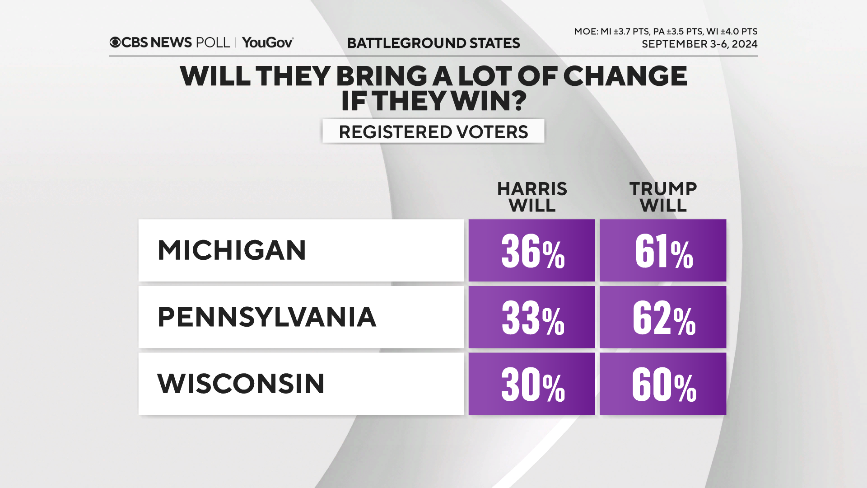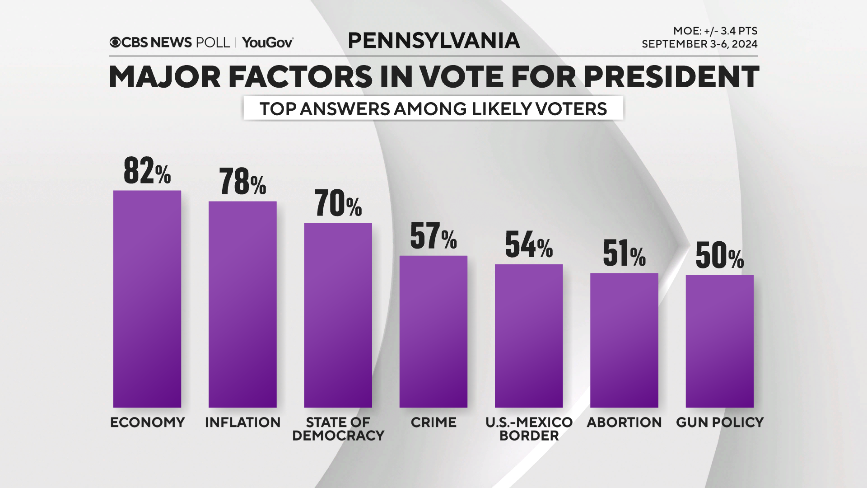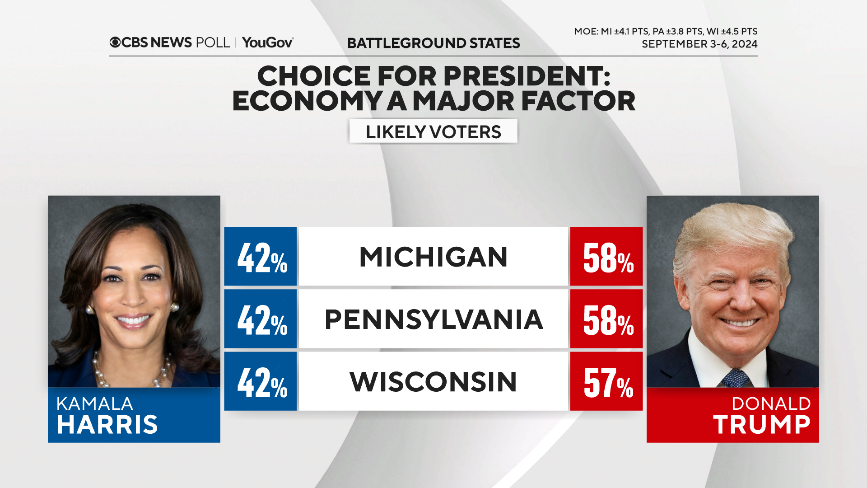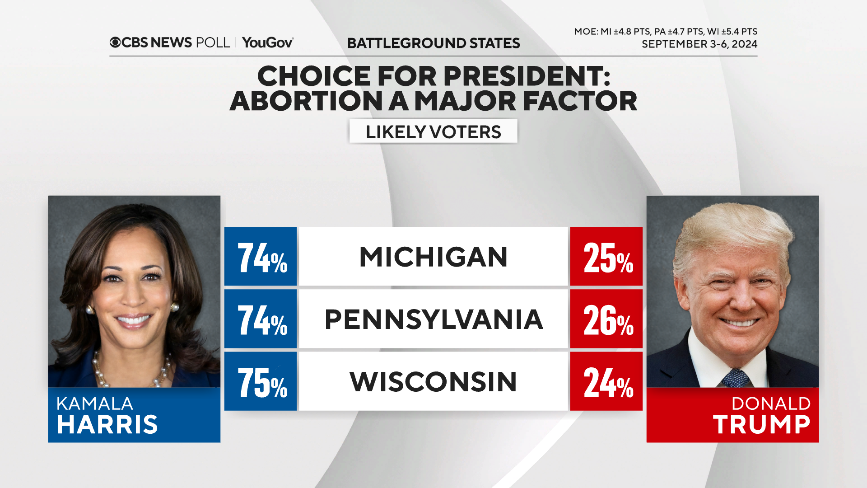CBS News
Harris v. Trump CBS News poll: Ahead of debate, here’s what voters are saying about the candidates

Here’s how voters in the 2024 battlegrounds of Michigan, Pennsylvania and Wisconsin view Vice President Kamala Harris and former President Donald Trump ahead of their first presidential debate.
Many voters say they don’t know what Harris stands for
Harris’ stances are less known than Trump’s. Roughly four in 10 voters in these battleground states say they don’t know what Harris stands for. Some of this is driven by Republicans — most of whom say they don’t know where she stands. But many independents hold this view too – a key voting group that is less firm in their candidate support, and not particularly excited about what they’ve seen from either of the campaigns recently.
More voters feel like they know where third-time Republican presidential nominee Donald Trump stands, whether they agree with him or not.
The debate is an opportunity for Harris to reintroduce herself and explain to voters how she will approach the issues they care about.
Likability: Advantage Harris – or is it?
More voters like how Kamala Harris handles herself personally than they do Donald Trump, and most of those who like them are voting for them.
But likability may not matter that much to some voters: A quarter of those who dislike Trump are voting for him anyway. This is not entirely new for Donald Trump. As we’ve seen over the years, a share of his supporters have overlooked some of Trump’s behavior they don’t particularly like.
This is less the case for Harris. The percentage of voters who dislike how she handles herself personally and are still voting for her is in the low single digits.
Who is the “change” candidate?
Harris and Trump are each trying to brand themselves as the “change candidate”, but in these battlegrounds, far more voters think it’s Trump who will bring “a lot” of change to the country if elected.
Throughout his presidency, President Biden has received low marks for handling key issues. Right now, Harris’ policies and views are seen as mostly – but not entirely – the same as President Biden’s, perhaps giving Harris an opportunity to distinguish herself in some way from him.
The issues: Will the debate change the candidate’s advantages and disadvantages?
While some things have changed with Harris now at the top of the Democratic ticket, some things have remained the same: Trump leads Harris — just like he did President Biden — among voters who say the economy and inflation are major factors in their vote – the top concerns for voters. We know from some of our earlier polling that when voters look back, more say the national economy under Trump was “good” than view it that way today.
On the U.S.-Mexico border, Republicans, in particular, say it is a major factor in their vote, and Trump leads on that issue, as he long has.
On the other hand: The issues of abortion and democracy are advantages for Harris. The abortion issue kept Democrats competitive in the 2022 midterms and it’s helping boost Harris today. She leads Trump by a wide margin among those who say abortion is a major factor in their vote.
And the state of democracy is an issue that Democrats in particular have emphasized, and here too, Harris bests Trump among those who place a great deal of importance on it.
The debate will give the candidates a chance to persuade voters they are the person who would better handle these key issues, perhaps changing some of the perceptions voters have of the candidates as it relates to these issues.
Fred Backus contributed to this report.
=====================================================================================
These CBS News/YouGov surveys were conducted between September 3-6, 2024. They are based on representative samples of 1,086 registered voters in Michigan, 1,085 in Pennsylvania, and 958 in Wisconsin. Margins of error for registered voters: Michigan +/- 3.7 points, Pennsylvania +/- 3.5 points, and Wisconsin +/- 4.0 points.
CBS News
Missing rabbi killed in the UAE in “heinous antisemitic terror incident,” Israel says
Israel said Sunday that the body of an Israeli-Moldovan rabbi who went missing in the United Arab Emirates has been found after he was killed in what it described as a “heinous antisemitic terror incident.”
The statement from Prime Minister Benjamin Netanyahu’s office said Israel “will act with all means to seek justice with the criminals responsible for his death.” There was no immediate comment from the UAE.
Zvi Kogan, 28, an ultra-Orthodox rabbi who went missing on Thursday, ran a Kosher grocery store in the futuristic city of Dubai, where Israelis have flocked for commerce and tourism since the two countries forged diplomatic ties in the 2020 Abraham Accords.
Jon Gambrell / AP
The agreement has held through more than a year of soaring regional tensions unleashed by Hamas’ Oct. 7, 2023 attack into southern Israel. But Israel’s devastating retaliatory offensive in Gaza and its invasion of Lebanon, after months of fighting with the Hezbollah militant group, have stoked anger among Emiratis, Arab nationals and others living in the UAE.
Iran, which supports Hamas and Hezbollah, has also been threatening to retaliate against Israel after a wave of airstrikes Israel carried out in October in response to an Iranian ballistic missile attack.
The Emirati government did not respond to a request for comment.
Early Sunday, the UAE’s state-run WAM news agency acknowledged Kogan’s disappearance but pointedly did not acknowledge he held Israeli citizenship, referring to him only as being Moldovan. The Emirati Interior Ministry described Kogan as being “missing and out of contact.”
“Specialized authorities immediately began search and investigation operations upon receiving the report,” the Interior Ministry said.
Netanyahu told a regular Cabinet meeting later Sunday that he was “deeply shocked” by Kogan’s disappearance and death. He said he appreciated the cooperation of the UAE in the investigation and said that ties between the two countries would continue to be strengthened.
Israel’s largely ceremonial president, Isaac Herzog, condemned the killing and thanked Emirati authorities for “their swift action.” He said he trusts they “will work tirelessly to bring the perpetrators to justice.”
Kogan was an emissary of the Chabad Lubavitch movement, a prominent and highly observant branch of ultra-Orthodox Judaism based in Brooklyn’s Crown Heights neighborhood in New York City. It said he was last seen in Dubai. The UAE has a burgeoning Jewish community, with synagogues and businesses catering to kosher diners.
The Rimon Market, a Kosher grocery store that Kogan managed on Dubai’s busy Al Wasl Road, was shut down Sunday. As the wars have roiled the region, the store has been the target of online protests by supporters of the Palestinians. Mezuzahs on the front and the back doors of the market appeared to have been ripped off when an Associated Press journalist stopped by on Sunday.
Kogan’s wife, Rivky, is a U.S. citizen who lived with him in the UAE. She is the niece of Rabbi Gavriel Holtzberg, who was killed in the 2008 Mumbai attacks.
The UAE is an autocratic federation of seven sheikhdoms on the Arabian Peninsula and is also home to Abu Dhabi. Local Jewish officials in the UAE declined to comment.
While the Israeli statement did not mention Iran, Iranian intelligence services have carried out past kidnappings in the UAE.
Western officials believe Iran runs intelligence operations in the UAE and keeps tabs on the hundreds of thousands of Iranians living across the country.
Iran is suspected of kidnapping and later killing British Iranian national Abbas Yazdi in Dubai in 2013, though Tehran has denied involvement. Iran also kidnapped Iranian German national Jamshid Sharmahd in 2020 from Dubai, taking him back to Tehran, where he was executed in October.
CBS News
Hyundai, Kia recall more than 208,000 electric vehicles over power loss issue

Hyundai and Kia are recalling more than 208,000 electric vehicles to fix a problem that can cause the loss of drive power, increasing the risk of a crash.
The recall covers more than 145,000 Hyundai and Genesis including some IONIQ 5 and IONIQ 6 EVs along with Genesis GV60, Genesis GV70 and Genesis G80 models.
The National Highway Traffic Safety Administration (NHTSA) said the vehicles’ transistors in a charging control unit may get damaged and stop charging the 12-volt battery, “which can result in a loss of drive power.”
In the Kia recall, nearly 63,000 EV6 vehicles from 2022 through 2024 are impacted.
Car dealers will inspect and replace the control unit and a fuse if needed, as well as update software. Owners whose vehicles were recalled earlier this year to fix the same problem will have to visit their dealer again.
Owners will be notified by letter in December and January.
CBS News
Here Comes the Sun: Jack Antonoff and more

Watch CBS News
Be the first to know
Get browser notifications for breaking news, live events, and exclusive reporting.



